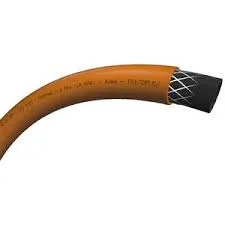335345435
Oct . 04, 2024 05:56 Back to list
thermoplastic high pressure hose
Understanding Thermoplastic High-Pressure Hoses
Thermoplastic high-pressure hoses are crucial components in various industrial applications, offering versatility, durability, and excellent performance. These hoses are primarily made from thermoplastic materials, which are polymers that become pliable or moldable upon heating. This characteristic enables manufacturers to create hoses that can withstand high pressures without compromising flexibility or ease of handling.
One of the main advantages of thermoplastic high-pressure hoses is their ability to combine strength and lightweight construction. Unlike traditional rubber hoses, thermoplastic options are often less dense, making them easier to maneuver. This is particularly beneficial in applications where hoses must be frequently repositioned or used in tight spaces.
Moreover, thermoplastic hoses are engineered to handle a wide range of temperatures and pressures. They can be designed to resist extreme conditions, including high temperatures, making them suitable for applications in the automotive, construction, and oil industries. The ability to maintain performance under diverse environmental factors is a significant advantage for businesses seeking reliable and long-lasting solutions.
Additionally, thermoplastic hoses exhibit excellent chemical resistance. They can be made to handle various fluids, including oils, fuels, and hydraulic fluids, making them indispensable in many industrial scenarios. This attribute is particularly vital in sectors where exposure to harsh chemicals is unavoidable, as it helps prevent degradation and extends the life of the hose.
thermoplastic high pressure hose

Another important aspect of thermoplastic high-pressure hoses is their reduced risk of kinking and bending. Traditional rubber hoses can easily become damaged when kinked, leading to reduced performance or failure. In contrast, the construction of thermoplastic hoses minimizes this risk, providing a reliable solution for high-pressure applications.
Installation and maintenance are also simplified with thermoplastic hoses. Their lightweight nature and flexibility facilitate easier installation, reducing labor costs and downtime during setup. Moreover, regular maintenance is straightforward, contributing to overall efficiency in keeping equipment operational.
Safety is a key factor in any high-pressure system, and thermoplastic hoses often feature enhanced safety measures compared to traditional alternatives. They are typically designed with burst-resistant capabilities, which can prevent leaks, spills, and other dangerous accidents in high-pressure environments. This feature is crucial not only for the protection of equipment but also for the safety of personnel working in these environments.
In conclusion, thermoplastic high-pressure hoses stand out due to their unique properties and benefits, making them the preferred choice in various applications across multiple industries. Their lightweight, flexibility, chemical resistance, and safety features provide a comprehensive solution for high-pressure needs. As industries continue to evolve, the demand for reliable and efficient components such as thermoplastic high-pressure hoses is expected to grow, reinforcing their status as a vital resource in modern engineering and industrial practices. Investing in these hoses is not merely a choice; it is a strategic decision towards enhanced operational efficiency and safety.
-
SAE 100 R17 Black Smooth Cover Hydraulic Hose
NewsMar.07,2025
-
SAE 100 R17 Black Smooth Cover Hydraulic Hose
NewsMar.07,2025
-
SAE 100 R17 Black Smooth Cover Hydraulic Hose
NewsMar.07,2025
-
SAE 100 R17 Black Smooth Cover Hydraulic Hose
NewsMar.07,2025
-
SAE 100 R17 Black Smooth Cover Hydraulic Hose
NewsMar.07,2025
-
steel wire braided hydraulic hose
NewsMar.07,2025



